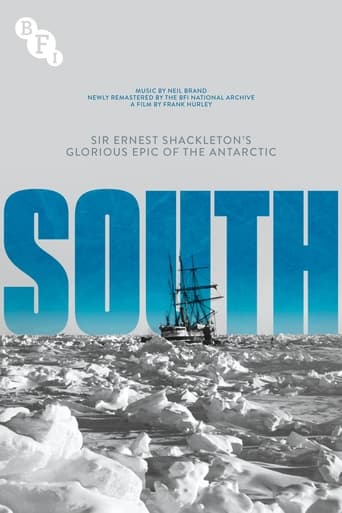

That was an excellent one.
... View MoreEach character in this movie — down to the smallest one — is an individual rather than a type, prone to spontaneous changes of mood and sometimes amusing outbursts of pettiness or ill humor.
... View MoreThere is, somehow, an interesting story here, as well as some good acting. There are also some good scenes
... View MoreThere's a more than satisfactory amount of boom-boom in the movie's trim running time.
... View More"South" (1919) by Frank Hurley with the cooperation of Ernest Shackleton is one of the rare pieces of evidence, very soon doing the searching in Antarctic continent and all its own backwardness as movie is concerning with such a reality of glacial activity, within also the fisheries and animals for the typical environment. Too, the spirit of geographical adventure is there, with some willingness from veterans of the Scott's expeditions and risky failures, as responsible background on the spot as usual in such a collective project, nurtured by Shackleton in it : to bring humanity from such an experiment in the last continent of our planet, where the footprints of some represented there, just before were lost for ever with its tent near the South pole.At its first stage, in contact with innocent human beings out of the First World War casualties, this Shackleton expedition got a discovery of what is fixed from onetime for ever, in such a fascinating way of holding images, moving like within that visual instinct. Pictures that would also be recuperated only a lot of years further, after standing perfectly conserved by the icy waters, in a submerged box inside the wreckage of the famous lost vessel, from that specific and interrupted expedition. In a kind of fact, that it was legend in the history of that forgotten region of the globe and this is almost incredible, as well rarely seen as a document restored, but still concerned with the insight of the trip on a failed mission. This movie is the recollection of part of the itinerary made by Shackleton team, specially the "Endurance" vessel slow wreckage and agony of sad evidence, with the polar sunny side of few moments nearby Antarctic. What should be done in homage to some of these past individuals, that took part in such an adventure ? Briefly, to such kind of human beings, now if it could be necessary for that comprehensive task, nothing less than going again in a further initiative. For repeating the trip, like it was before, it was rather obligatory facing an almost permanent Winter without the Sun in the most part of the year. This occurring still in such a similar kind of conditions, as though even having the same and getting the enraged flesh of the local seals and bears for the meals as it was made in the past, animals that such an expedition ate before, in last instance for surviving. All that working, when people still at the time was obliged then, while encircled by severe glacial circumstances, burning coal to stay alive. Even with their frozen noses perhaps not alive, but saving partly of it in supplies and returning from nowhere, again at home.
... View MoreA truly amazing film, and at least one good thing to come as a result of British self-importance. Film was still in its early years; leave it to the Brits to capitalize on it to record their abortive undertaking at the south pole. Still it is an admirable effort, and the photography is often startling, especially since the Milestone release. Thanks to the previous commentor for the bibliography, as I too had to wonder what became of the sled dogs, who seemed at least as dedicated as their human counterparts.
... View MoreUntil this showed up on TCM's recent documentary series I had no idea that this film existed. It is a truly remarkable document of Shackleton's expedition to the South Pole in 1914 that turned into a two year adventure on ice.Save for some cute animal footage at the end that seems designed to pad the running time, this is a perfect film.
... View MoreThis film has recently been shown with the title "SOUTH Sir Ernest Shackleton's glorious epic of the Antarctic". Considering what cinematographer Frank Hurley had to work with as equipment and the hardships under which he was working, it really is an amazing film. Think, too, that probably most of his footage and still photographs had to be abandoned as the 28 men fought just to stay alive after their ship "Endurance" was crushed by the ice and sank. Shackleton hoped to land on the coast of Antarctica and cross the continent using dog sleds, then be picked up on the other coast by his ship. Alas, the winter of 1914-1915 turned out to be one of worst in the known history of the frozen continent to that time, and their ship was ice bound and destroyed before they ever reached the shore south of Elephant Island and the farther north island of South Georgia. What we are shown here is mostly the earlier part of the saga before the conditions grew really bad. The latter part is covered mostly by still pics and some artists drawings, pieced out by movies of bird and seal life around South Georgia. This last may prove tedious for some, but the rest is very interesting. For a really detailed account of Shackleton's adventure consult ENDURANCE: Shackleton's Incredible Voyage by Alfred Lansing (McGraw-Hill, 1959) which I imagine many libraries will have.
... View More